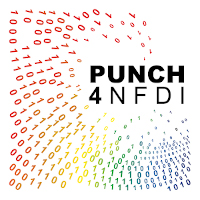Conveners
Public Session: Open presentations I
- There are no conveners in this block
Public Session: Open presentations II
- There are no conveners in this block
Public Session: Open presentations III
- There are no conveners in this block
Public Session: Farewell
- Thomas Schörner (DESY)
Public Session: Poster session & Coffee
- There are no conveners in this block
REANA is a connecting engine that enables workflows for scientific tasks and access to the required resources. Basic features and usage will be demonstrated.
This contribution is thought as a slot for initial discussion on input from PUNCH to the strategy meeting of the ErUM Digitization Board with the BMBF to prepare the next round of project calls.
A short introduction will be given to stimulate the discussion.
The rapid development of detector technology, including these sensitive to gravitational waves and neutrinos, has brought us to the gate of an era where we will be able to observe transient events as they unfold throughout a large fraction of the Universe. The availability of these data floods requires new systems for data processing and the consistent application of modern statistical...
The detection of radio signals originating from pulsars poses a formidable challenge, mainly due to the omnipresent terrestrial and extraterrestrial radio interference. In view of the upcoming Square Kilometre Array Observatory (SKAO) with its huge data streams, the interfering signals have to be identified in real time already during the data acquisition phase. For this reason, we have...
In order to provide PUNCH4NFDI users with digital research products (DPRs) through PUNCH4NFDI Science Data Portal in a FAIR way, one should enable users with the opportunity to discover DRPs (which is achieved by the use of descriptional metadata) and as well provide them with a decent amount of other information for decision-making (such as legal, structural, etc. metadata). Generic metadata...
The search for dark matter (DM) is a long-standing quest. Accelerator and underground experiments provide direct limits on DM. Using astronomical observations at TeV energies, it is possible to derive indirect limits on the annihilation cross section of DM particles. While original data, pipelines, and even derived data are typically not available for joint analyses, we illustrate the TA6 work...
Rare decays like $B^+ \to K^+ \nu \bar{\nu}$, searched for by the Belle II collaboration, are important in particle physics research as they offer a window into physics beyond the Standard Model. However, the experimental challenges induced by the two final state neutrinos require assumptions on the kinematic distribution of this decay. Consequently, the results feature a model dependency...
Over the last decades of the developments in radio astronomy, the data rates and data complexity increased many times over. It is connected to multiple factors, among which the fact that the main focus of the radio astronomical research was shifted towards time-varying and transient signals. In addition to that, the technological development of the variety of ground- and space-based...

